The Design of a Dual-Band 4-Port Magnetic Resonant Wireless Power Transfer Coupler: Theoretical Analysis of Losses and Interference for Biomedical Wearable Applications
Abstract
1. Introduction
- The PEC model achieves high fidelity to measurements, enabling accurate prediction of dual-band performance metrics like power Loss and efficiency with errors below 5%.
- Cross-band interference is quantified at levels below −20 dB, linking calculated leakage to efficiency reductions in multi-port systems.
2. Materials and Methods
2.1. Coupler Design and Parameter Extraction Method
2.2. Loss Prediction and Interference Analysis
3. Results and Discussion
4. Conclusions
Author Contributions
Funding
Data Availability Statement
Conflicts of Interest
References
- Marangalou, A.H.; Gonzalez, M.; Reppucci, N.; Guler, U. A Design Review for Biomedical Wireless Power Transfer Systems with a Three-Coil Inductive Link through a Case Study for NICU Applications. Electronics 2024, 13, 3947. [Google Scholar] [CrossRef]
- Khan, S.R.; Pavuluri, S.K.; Cummins, G.; Desmulliez, M.P.Y. Wireless Power Transfer Techniques for Implantable Medical Devices: A Review. Sensors 2020, 20, 3487. [Google Scholar] [CrossRef] [PubMed]
- Alrashdan, F.T.; Chen, J.C.; Singer, A.; Avants, B.W.; Yang, K.; Robinson, J.T. Wearable Wireless Power Systems for ‘ME-BIT’ Magnetoelectric-Powered Bio Implants. J. Neural Eng. 2021, 18, 045011. [Google Scholar] [CrossRef] [PubMed]
- Gong, C.; Liu, D.; Miao, Z.; Wang, W.; Li, M. An NFC on Two-Coil WPT Link for Implantable Biomedical Sensors under Ultra-Weak Coupling. Sensors 2017, 17, 1358. [Google Scholar] [CrossRef] [PubMed]
- Shah, I.A.; Zada, M.; Basir, A.; Shah, S.A.A.; Iman, U.R.; Lim, Y.-H.; Yoo, H. Efficient Wirelessly Powered Biotelemetric System for IoMT-Enabled Leadless Pacemakers in Dynamic Cardiac Environments. IEEE Internet Things J. 2025, 12, 6917–6929. [Google Scholar] [CrossRef]
- Ben Ammar, M.; Ben Dhaou, I.; El Houssaini, D.; Sahnoun, S.; Fakhfakh, A.; Kanoun, O. Requirements for Energy-Harvesting-Driven Edge Devices Using Task-Offloading Approaches. Electronics 2022, 11, 383. [Google Scholar] [CrossRef]
- Abbas, N.; Basir, A.; Ali Shah, I.; Rizqi Iman, U.; Yoo, H. Development of an Efficient Mid-Field Wireless Power Transmission System for Biotelemetric IoT Medical Devices. Sci. Rep. 2025, 15, 14889. [Google Scholar] [CrossRef]
- RamRakhyani, A.K.; Lazzi, G. Multi-coil Approach to Reduce Electromagnetic Energy Absorption for Wirelessly Powered Implants. Healthc. Tech. Lett. 2014, 1, 21–25. [Google Scholar] [CrossRef]
- Awuah, C.M.; Danuor, P.; Moon, J.-I.; Jung, Y.-B. Novel Coil Design and Analysis for High-Power Wireless Power Transfer with Enhanced Q-Factor. Sci. Rep. 2023, 13, 4187. [Google Scholar] [CrossRef]
- Yoon, S.; Lim, T.; Lee, Y. Multifunctional coil technique for alignment-agnostic and Rx coil size-insensitive efficiency enhancement for wireless power transfer applications. Sci. Rep. 2023, 13, 22838. [Google Scholar] [CrossRef]
- Yadav, A.; Bera, T.K. A Critical Review of Electromagnetic Coil Assembly Design and Optimization for Wireless Power Transfer in Electric Vehicles: Technical Insights. Renew. Sustain. Energy Rev. 2025, 223, 115944. [Google Scholar] [CrossRef]
- Machnoor, M.; Gamez Rodriguez, E.S.; Kosta, P.; Stang, J.; Lazzi, G. Analysis and Design of a 3-Coil Wireless Power Transmission System for Biomedical Applications. IEEE Trans. Antennas Propag. 2019, 67, 5012–5024. [Google Scholar] [CrossRef]
- Alghrairi, M.; Sulaiman, N.; Mutashar, S.; Hasan, W.Z.W.; Jaafar, H.; Algriree, W. Designing and Analyzing Multi-Coil Multi-Layers for Wireless Power Transmission in Stent Restenosis Coronary Artery. AIP Adv. 2022, 12, 125315. [Google Scholar] [CrossRef]
- Kung, M.-L.; Lin, K.-H. Dual-Band Coil Module With Repeaters for Diverse Wireless Power Transfer Applications. IEEE Trans. Microw. Theory Tech. 2018, 66, 332–345. [Google Scholar] [CrossRef]
- Le-Huu, H.; Seo, C. Dual-Band Free-Positioning Transmitting Coil for Multiple-Receiver Wireless Power Transfer. IEEE Access 2021, 9, 107298–107308. [Google Scholar] [CrossRef]
- Iqbal, A.; Sura, P.R.; Al-Hasan, M.; Mabrouk, I.B.; Denidni, T.A. Wireless Power Transfer System for Deep-Implanted Biomedical Devices. Sci. Rep. 2022, 12, 13689. [Google Scholar] [CrossRef]
- Ojha, S.S.; Singhal, P.K.; Thakare, V.V. Dual-Band Rectenna System for Biomedical Wireless Applications. Meas. Sens. 2022, 24, 100532. [Google Scholar] [CrossRef]
- Mahmud, S.; Nezaratizadeh, A.; Satriya, A.B.; Yoon, Y.-K.; Ho, J.S.; Khalifa, A. Harnessing Metamaterials for Efficient Wireless Power Transfer for Implantable Medical Devices. Bioelectron. Med. 2024, 10, 7. [Google Scholar] [CrossRef] [PubMed]
- Le-Huu, H.; Seo, C. Dual-Band Transmitter for Wireless Power Transfer to Biomedical Implant Applications. Antennas Wirel. Propag. Lett. 2023, 22, 1461–1465. [Google Scholar] [CrossRef]
- Byron, K.; Winkler, S.A.; Robb, F.; Vasanawala, S.; Pauly, J.; Scott, G. An MRI Compatible RF MEMs Controlled Wireless Power Transfer System. IEEE Trans. Microw. Theory Tech. 2019, 67, 1717–1726. [Google Scholar] [CrossRef]
- Martins, I.S.; Silva, H.F.; Lazareva, E.N.; Chernomyrdin, N.V.; Zaytsev, K.I.; Oliveira, L.M.; Tuchin, V.V. Measurement of Tissue Optical Properties in a Wide Spectral Range: A Review [Invited]. Biomed. Opt. Express 2023, 14, 249. [Google Scholar] [CrossRef] [PubMed]
- Bae, H.; Park, S. Design of an Integrated Near-Field Communication and Wireless Power Transf. Coupler for Mobile Device Applications. Technologies 2025, 13, 207. [Google Scholar] [CrossRef]
- Bae, H.; Park, S. Design of Four-Plate Parallel Dynamic Capacitive Wireless Power Transfer Coupler for Mobile Robot Wireless-Charging Applications. Appl. Sci. 2025, 15, 823. [Google Scholar] [CrossRef]
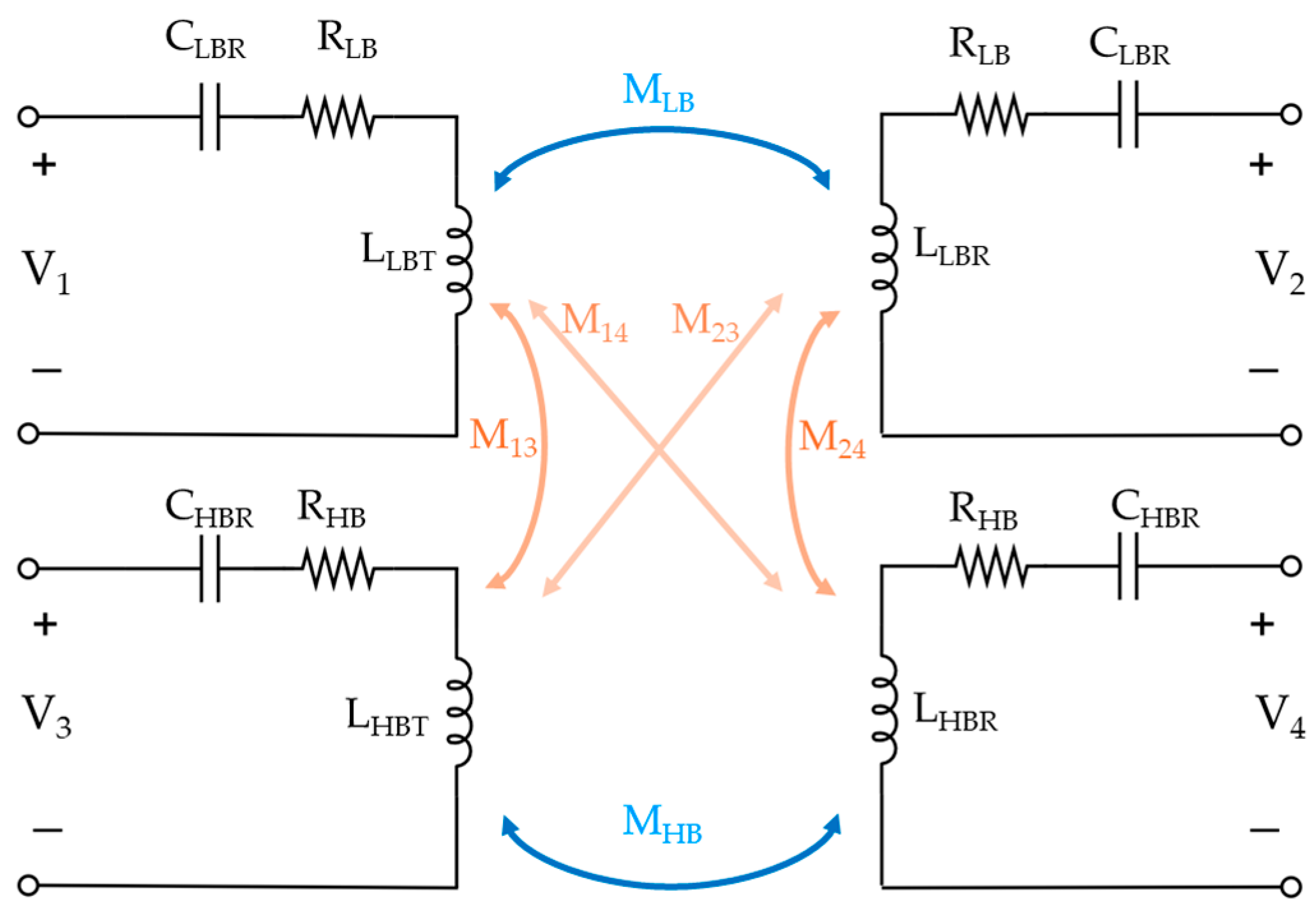

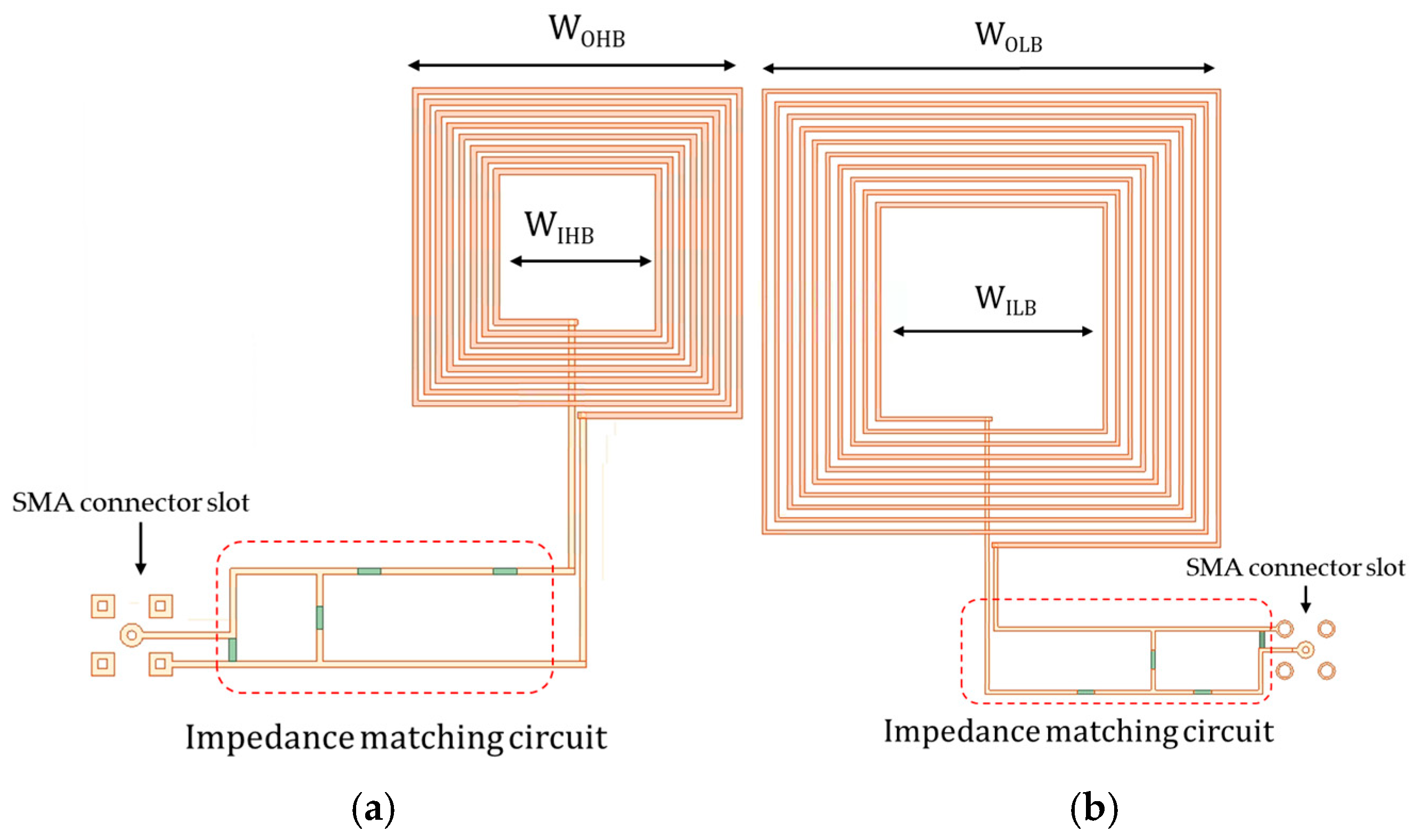
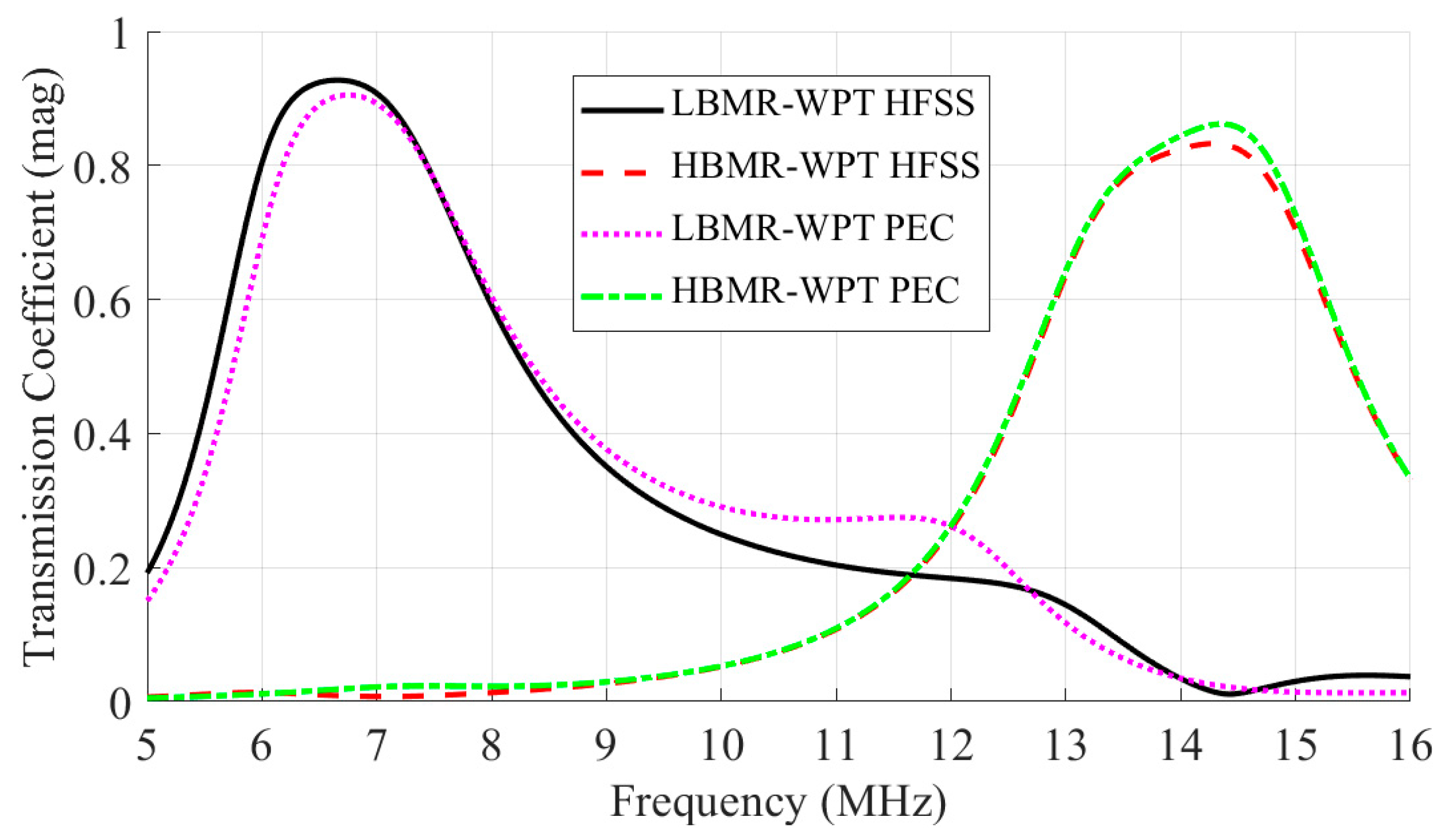



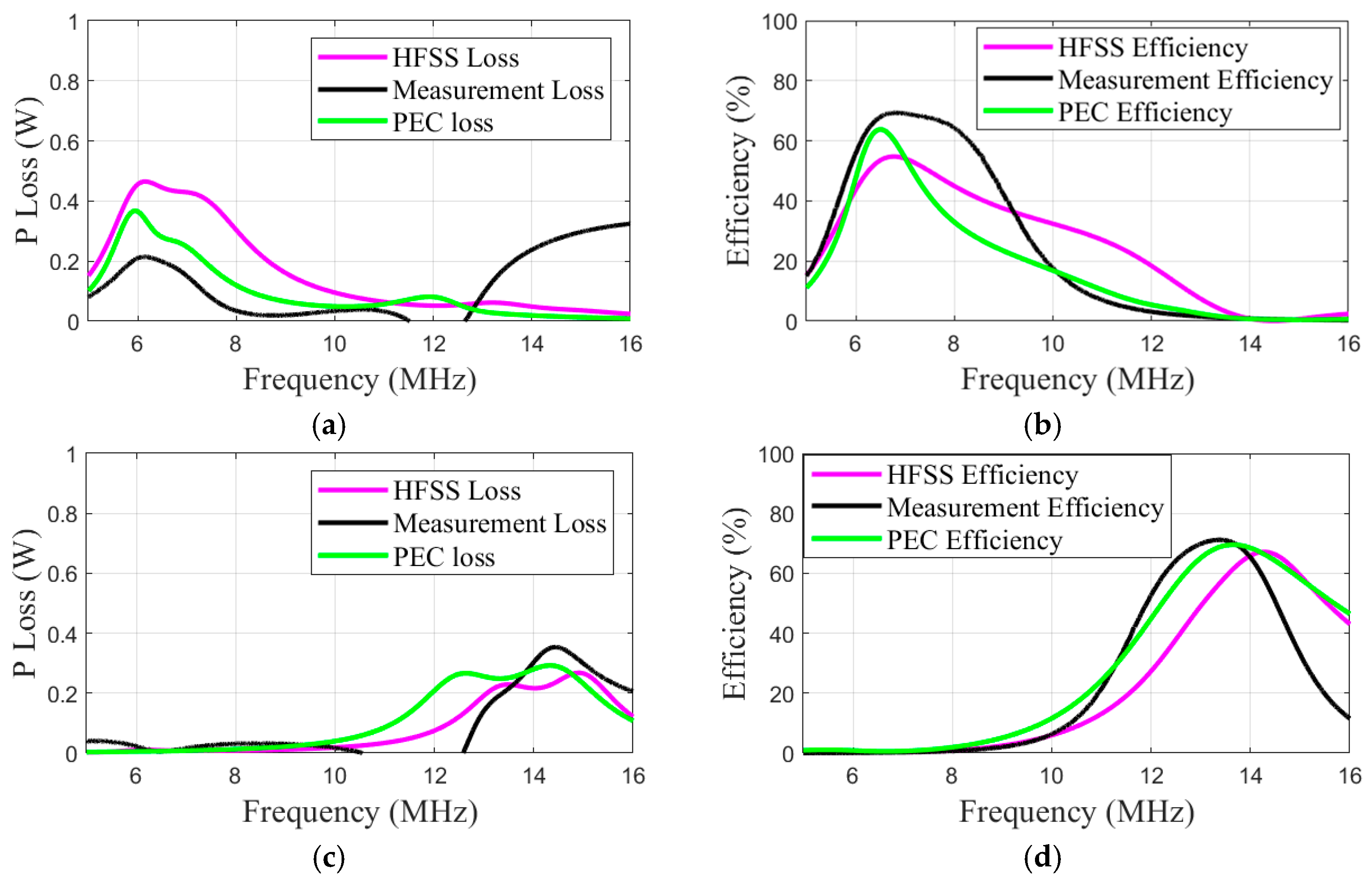
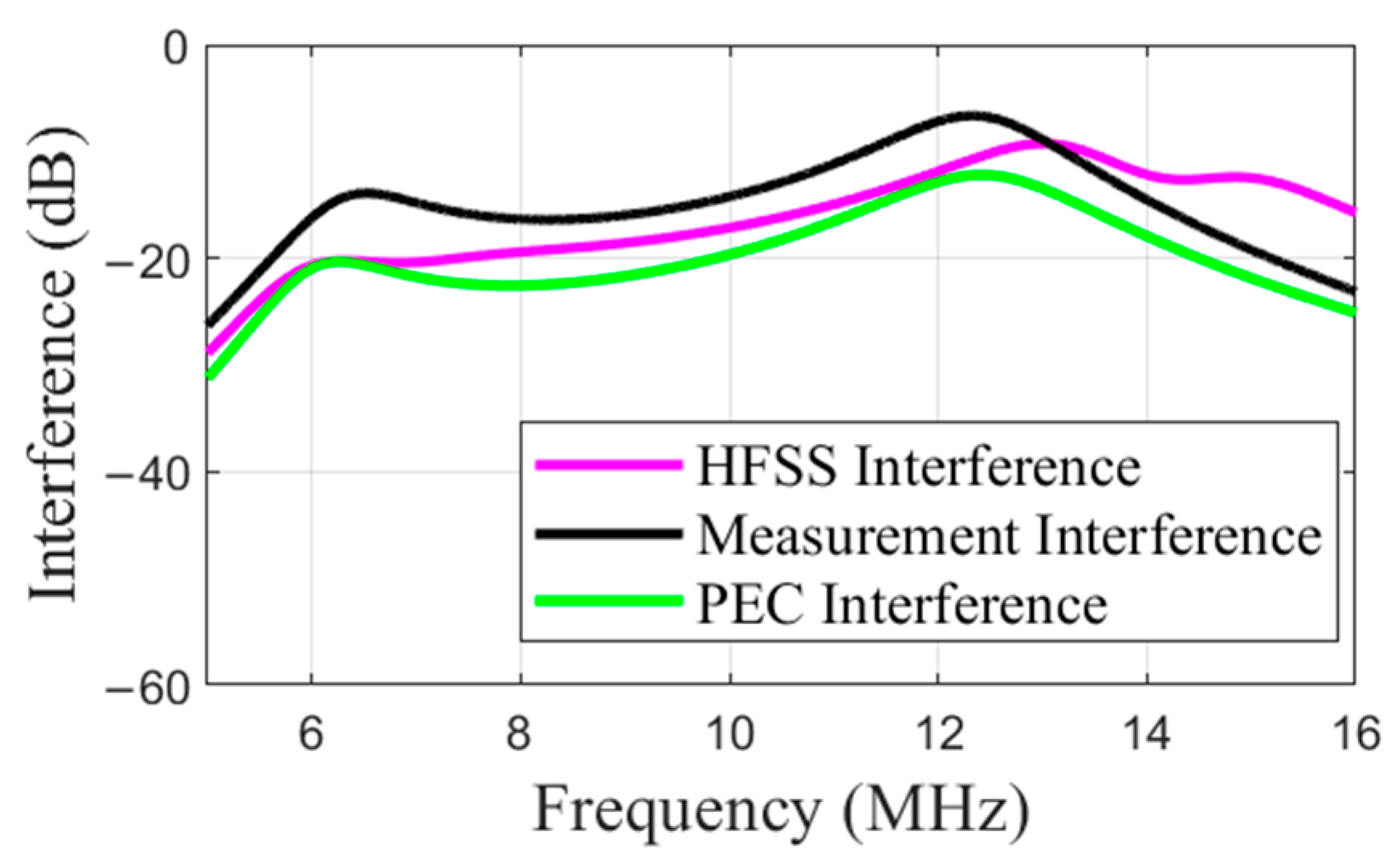
| Types | Corresponding Circuit Networks |
|---|---|
| [T]TypeA | [T]HBT, [T]HBR |
| [T]TypeB | [T]MHB, [T]MLB, [T]MTT, [T]MRR, [T]MHL |
| [T]TypeD | [T]LBT, [T]LBR |
| Components | Value |
|---|---|
| LBMR-WPT coil outer width (WOLB) | 55 mm |
| LBMR-WPT coil inner width (WILB) | 27 mm |
| LBMR-WPT conductor line spacing | 1 mm |
| LBMR-WPT conductor line width | 0.5 mm |
| HBMR-WPT coil outer width (WOHB) | 29 mm |
| HBMR-WPT coil inner width (WIHB) | 13 mm |
| Ferrite side length | 32 mm |
| Distance between HB and LB MR-WPT coils (equal to RX) | 2 mm |
| Spacing between HBMR-WPT Tx and Rx | 15 mm |
| Substrate length | 100 mm |
| Substrate width | 84 mm |
| Notation | Components | Value |
|---|---|---|
| LHB | Self-inductance of the HB MR-WPT coupler | 2.7 μH |
| LLB | Self-inductance of the LB MR-WPT coupler | 5.95 μH |
| RHB | Resistance of the HB MR-WPT coupler | 1.2 Ω |
| RLB | Resistance of the LB MR-WPT coupler | 2.7 Ω |
| MHB | Mutual inductance between Tx and Rx in the HBMR-WPT | 1.8 μH |
| MLB | Mutual inductance between Tx and Rx in the LBMR-WPT | 2.25 μH |
| MHL | Cross mutual inductance between Tx and Rx | 0.4 μH |
| MTX, MRX | Cross mutual inductance between Tx or Rx | 1.2 μH |
| kHB | Coupling coefficient within the HBMR-WPT | 0.66 |
| kLB | Coupling coefficient within the LBMR-WPT | 0.25 |
| kHL | Cross coupling coefficient between HB and LB MR-WPT | 0.23 |
| Notation | Components | Value |
|---|---|---|
| LHB | Self-inductance of the HB MR-WPT coupler | 2.7 μH |
| LLB | Self-inductance of the LB MR-WPT coupler | 5.95 μH |
| RHB | Resistance of the HB MR-WPT coupler | 5.5 Ω |
| RLB | Resistance of the LB MR-WPT coupler | 1.2 Ω |
| MHB | Mutual inductance between Tx and Rx in the HBMR-WPT | 4 μH |
| MLB | Mutual inductance between Tx and Rx in the LBMR-WPT | 4.2 μH |
| MHL | Cross mutual inductance between Tx and Rx | 4.4 μH |
| MTX, MRX | Cross mutual inductance between Tx or Rx | 4 μH |
| kHB | Coupling coefficient within the HBMR-WPT | 0.6 |
| kLB | Coupling coefficient within the LBMR-WPT | 0.42 |
| kHL | Cross coupling coefficient between HB and LB MR-WPT | 0.5 |
| Method | Max Loss (W) | Max Efficiency (%) | ||
|---|---|---|---|---|
| LBMR-WPT | HBMR-WPT | LBMR-WPT | HBMR-WPT | |
| HFSS | 0.47 | 0.27 | 54.76 | 67.13 |
| PEC | 0.37 | 0.29 | 63.49 | 69.52 |
| Measurement | 0.22 | 0.35 | 69.33 | 71.18 |
Disclaimer/Publisher’s Note: The statements, opinions and data contained in all publications are solely those of the individual author(s) and contributor(s) and not of MDPI and/or the editor(s). MDPI and/or the editor(s) disclaim responsibility for any injury to people or property resulting from any ideas, methods, instructions or products referred to in the content. |
© 2025 by the authors. Licensee MDPI, Basel, Switzerland. This article is an open access article distributed under the terms and conditions of the Creative Commons Attribution (CC BY) license (https://creativecommons.org/licenses/by/4.0/).
Share and Cite
Bae, H.-G.; Park, S.-W. The Design of a Dual-Band 4-Port Magnetic Resonant Wireless Power Transfer Coupler: Theoretical Analysis of Losses and Interference for Biomedical Wearable Applications. Electronics 2025, 14, 3637. https://doi.org/10.3390/electronics14183637
Bae H-G, Park S-W. The Design of a Dual-Band 4-Port Magnetic Resonant Wireless Power Transfer Coupler: Theoretical Analysis of Losses and Interference for Biomedical Wearable Applications. Electronics. 2025; 14(18):3637. https://doi.org/10.3390/electronics14183637
Chicago/Turabian StyleBae, Hong-Guk, and Sang-Wook Park. 2025. "The Design of a Dual-Band 4-Port Magnetic Resonant Wireless Power Transfer Coupler: Theoretical Analysis of Losses and Interference for Biomedical Wearable Applications" Electronics 14, no. 18: 3637. https://doi.org/10.3390/electronics14183637
APA StyleBae, H.-G., & Park, S.-W. (2025). The Design of a Dual-Band 4-Port Magnetic Resonant Wireless Power Transfer Coupler: Theoretical Analysis of Losses and Interference for Biomedical Wearable Applications. Electronics, 14(18), 3637. https://doi.org/10.3390/electronics14183637







